The Secrets of Japanese Gardens are Revealed
Overview of Oriental Gardens
These gardens become an idealization of nature. In the Asian garden you can discover something of the heart of nature. The visitor can relate herself to nature.
A good garden takes you on a journey in mind, body and spirit. It contains human warmth, naturalness, strength, simplicity and sometimes humor. Use the KISS (Keep It Simple) rule when completing your garden design concept.
A brand new Japanese Garden Designs Package has been added to our portfolio. It combines our best Japanese designs into one low cost package, ready for instant download. This offer expires soon. This package complements our other top designs, a Mediterranean Garden Design, and a Tropical Garden Plan.
Japanese gardens please the beholder
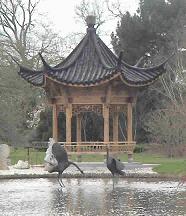
They have a feeling of space that gives us a feeling of freedom. Even small garden designs must be done in such a way as to create space. An enclosure of some sort in the garden will give you a feeling of privacy. This is important for a meditation garden design .
In your Oriental garden design you must use old things, e.g. a moss covered lantern. Use many things that have an aged look of antiquity. This is part of the Oriental tradition. By linking the past to the future, a sort of nostalgia is sensed.
The seasons are celebrated in the Japanese
garden.
Design your garden
to show the change of season from winter to spring. The change symbolizes a new birth, perhaps a new beginning for you.
There is much interest because not everything is revealed to the viewer in one instance. Surprises lie behind the hedge. The astute Japanese garden designer will hide things in the garden in strategic places. The objects will only be revealed as a visitor moves through
the garden.
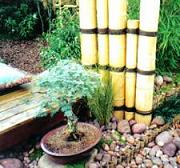
Human principles come across quite strongly in Japanese Gardens. Design the garden to create unity and harmony. This is done by linking the house to the garden. This has the effect of linking spiritual unity with nature.
Oriental gardens contain much logic. Things in them must point to truth, reflect our daily lives, and also contain the realities of our environment in them.
The feeling of stillness and serenity evokes much interest. The deep symbolic meanings and developed artistry, stirs an implanted reverence for nature in the Japanese garden. Design your garden so that it is shielded from noise. This creates an ideal environment for relaxation and meditation.
Symbolism in Japanese Gardens
Gardens trigger peoples’ senses, whether good or bad. Beautiful gardens strike psychological and emotional responses within us. Some Orientals believe that by going to nature, they link their unconscious selves, unknowingly, to their evolutionary past. Thus their gardens are used as a form of worship.
Ponds containing lotus flowers are symbolic. Lotus flowers are the symbol of enlightenment. The roots are embedded in mud, the symbol of passions. The flowers and leaves are open to the sun (and purity).
Developing a Sensitivity
Here is the story of Sen no Rikyu, the great tea master:
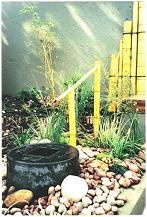
Only when the guest bent over the water basin to dip for water with his hands, could he see through a break between the hedges. It was deliberately done in the hope that the guest would see his reflection in the water basin. Then when the guest looked up to see the infinite ocean, he would realize that the water and the ocean are one. In the same way he would realize that the mind and universe are one.”
Traditional garden designers studied natural landscapes and landscapes painted by artists. They therefore developed an artistic eye for garden design. They strive to recreate the natural scene in a garden in its simplified form.
Orientals have developed a much sought after sensitivity to nature. This reflects in Japanese landscape designs. It also contributes to the effectiveness of these designs as Meditation Gardens .
Climate and Topography for Japanese Gardens
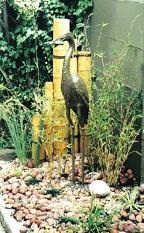 Only 20% of the islands in Japan can be cultivated. The fields are a mosaic of dykes. The Japanese were thus forced to master the skill of manipulating water.
Only 20% of the islands in Japan can be cultivated. The fields are a mosaic of dykes. The Japanese were thus forced to master the skill of manipulating water. The much prized moss found in Japan relies on the humid growing conditions. In the Japanese garden design, lanterns must be covered in moss to attain that aged look. The lantern must be placed in a humid, shady area. TIP: Paint the lantern with natural yoghurt or spray it with plant food to encourage moss growth. Give rocks the same treatment if required.
All Oriental gardens will have water in them.
Where water is impractical a river of pebbles symbolizing a river is used. Water is a commodity of this world and fresh water is regarded as sacred. Hide the source of the waterfall, if your garden design includes a waterfall. Cover the water source using a plant with large overhanging leaves, or let the
water come from elsewhere. The Japanese are
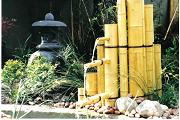
renowned for the concept of creating unity in the home and garden. A good design will link the home to the Japanese garden. Design the garden to merge with the home into one visual room. The picture of the bonsai tree and bamboo backdrop is an example of this concept. A gazebo may also be used in some gardens to create this effect.
Orientals believe that when their ancestors die, they go to the mountains. They sometimes have a rock or stone symbolizing a mountain in their oriental garden. Designs also include trees and unusual shaped rocks with ropes wrapped around them. They are used as a form of worship.
They also wash their hands and rinse their mouths before worshipping. Include a hand basin and a suitable rock in your Japanese garden design concept, if you want to emphasize the religious aspect.
An Oriental garden is not just a beautiful garden, but can also be a
Meditation Retreat
where you can enjoy relaxing. The attention to detail and mystique adds to the meditation experience.
Download a Free Award Winning Garden Design
Attention: This is limited to the next 7 lucky individuals
“The FREE Shed Plan and Garden Improvement Project ”








